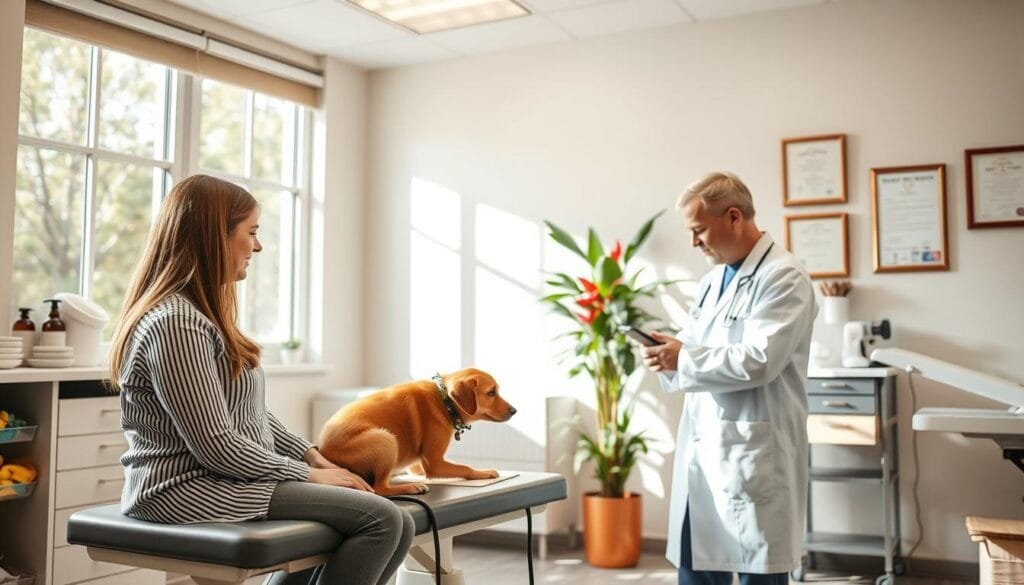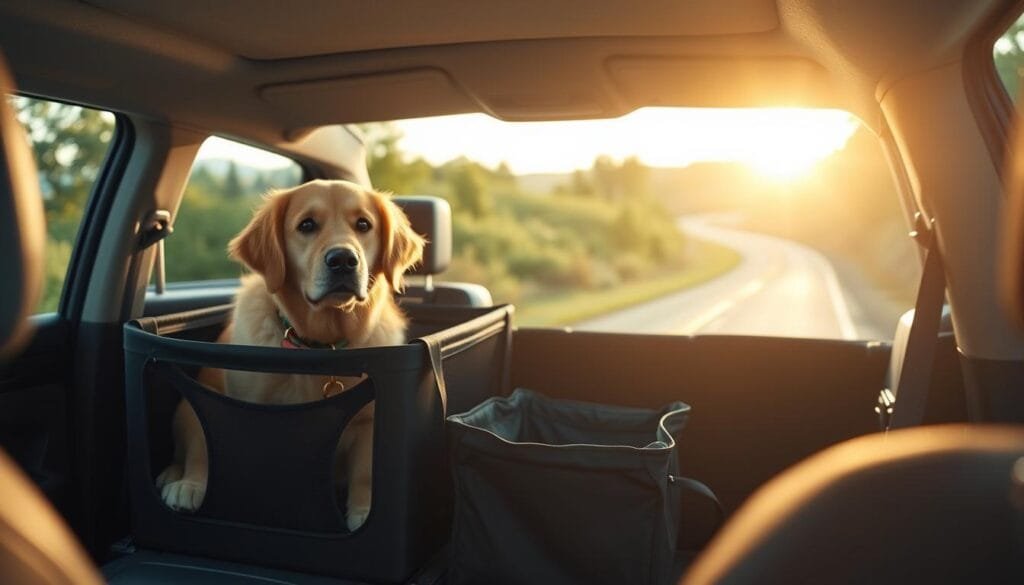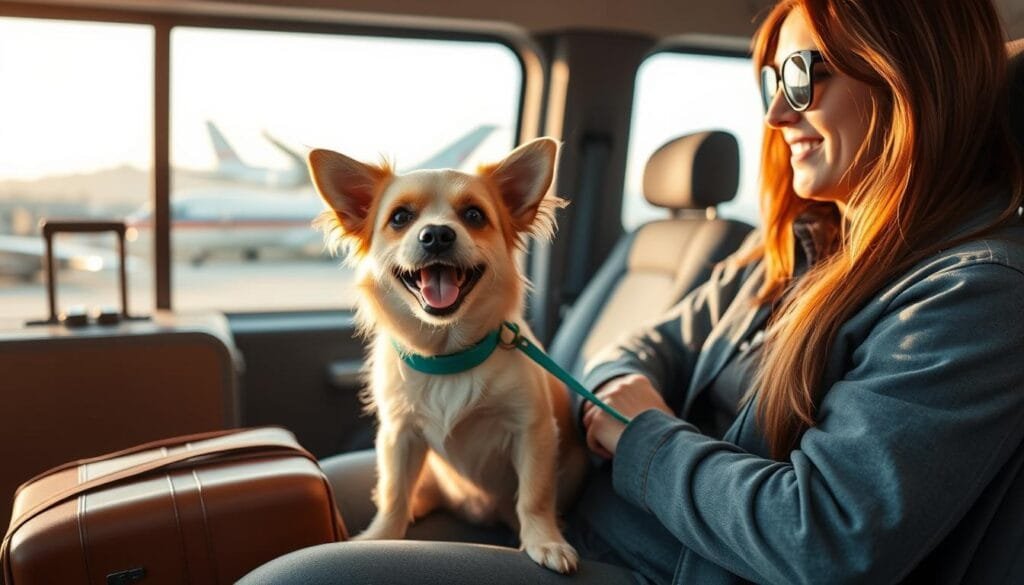Affiliate Disclosure: Travel with Plastic may earn a commission or referral bonus from some links on this site. These affiliate links help support our work and may influence the placement or promotion of certain products or services. However, our content is independently crafted to reflect honest opinions. Not all offers or products are included. There is no additional cost to users when they utilize our affiliate links.
A recent survey reveals that 78% of American pet owners traveled with their pets in 2024. This trend shows that more people consider pets as family members. Understanding pet travel is now essential for a great experience.
This guide covers key pet travel tips and strategies. We’ll discuss pre-travel prep and creating pet-friendly plans. You’ll learn how to handle challenges and enjoy adventures with your furry friend.
We’ll explore pet travel essentials for road trips and flights. Our aim is to ensure a safe and fun journey for you and your pet. Get ready to make your next trip a tail-wagging success!
Key Takeaways
- 78% of American pet owners traveled with their pets in 2024
- Pre-travel health checks and documentation are crucial
- Choose pet-friendly transportation and accommodation
- Pack essential pet travel gear and supplies
- Create a pet-friendly itinerary for a stress-free trip
- Understand air travel regulations for pets
- Implement stress reduction techniques for your pet during travel
Pre-Travel Health Assessment and Documentation
Traveling with your pet? Health checks and paperwork are vital. Proper planning ensures a safe journey for your furry friend.
Veterinary Check-ups and Health Certificates
Book a vet visit months before your trip. Many places need health certificates issued within 10 days of travel.
This rule applies to all pets, not just dogs. Surprisingly, 40% of pet owners forget this for cats and other animals.

Required Vaccinations and Documentation
Vaccine needs differ by destination. Rabies shots are common, but some countries require more.
About half of nations need a rabies vaccination certificate. Keep up with changing requirements to avoid issues.
Medication Planning and Emergency Preparations
Plan medication schedules for pets with health issues. Pack a pet first aid kit and know emergency vet locations.
Consider using calming aids for anxious pets. Studies show 40% of pets get stressed during travel.
Good preparation is crucial for pet travel safety. Follow these tips for a smooth trip with your pet.
| Travel Preparation Statistic | Percentage |
|---|---|
| Pet owners planning annual travel with pets | 70% |
| Pet owners experiencing travel-related stress | 30% |
| Pets with reduced stress due to pre-travel crate familiarity | 60% |
Choosing the Right Mode of Transportation
Selecting the best travel method is crucial for pet transportation. Road trips offer flexibility and comfort for you and your furry friend. Stop every 2-3 hours to let your pet stretch and relieve themselves.
For car travel, invest in a dog seatbelt or safety harness. This ensures your pet’s safety during the journey.

Air travel with pets requires more planning. Airlines typically allow only 1-2 pets per flight in the cabin. Book early and get a health certificate from your vet.
Your pet must fit under the seat in a carrier. Larger animals may need to travel in the cargo hold.
Train travel might be an option for those traveling with cats. Amtrak allows cats and small dogs up to 20 pounds on some routes.
Most interstate bus companies don’t permit pets, except for service animals. Always check pet policies before booking any transportation.
| Transportation Mode | Pet-Friendly Rating | Key Considerations |
|---|---|---|
| Car | High | Frequent stops, safety equipment |
| Plane | Medium | Size restrictions, health certificates |
| Train | Low-Medium | Weight limits, limited routes |
| Bus | Very Low | Generally not allowed |
Most pet owners prefer car travel for its convenience and comfort. Prioritize your pet’s well-being and follow all guidelines for a smooth journey.
Essential Pet Travel Gear and Supplies
Packing the right pet accessories is key for a smooth trip with your furry friend. This guide covers must-have items for pet safety and comfort during travel.
Carrier Selection and Comfort Items
Choose a carrier that’s spacious enough for your pet to move comfortably. For air travel, check that it meets airline rules. Include familiar blankets or toys to help your pet relax.
Food and Water Supplies
Pack your pet’s regular food, collapsible bowls, and spill-proof water containers. For air travel, offer water within four hours before check-in. Avoid feeding your pet within four hours of the flight.
First Aid Kit Components
A pet first aid kit is crucial for your travels. Include these essential items:
- Bandages and gauze
- Antiseptic wipes
- Tweezers
- Any prescribed medications
Identification and Safety Equipment
Make sure your pet wears current ID tags and has a microchip. A GPS tracker can provide extra security. These steps help reunite you with your pet if they get lost.
| Item | Purpose | Importance |
|---|---|---|
| Carrier | Safe transport | Essential |
| Comfort items | Reduce anxiety | High |
| Food and water supplies | Nutrition and hydration | Essential |
| First aid kit | Emergency care | Critical |
| ID tags and microchip | Identification | Crucial |
Pet-Friendly Accommodation Planning
Finding the right pet-friendly lodging is crucial for a successful vacation. We’ve gathered tips to help you choose the perfect spot for you and your furry friend.
Researching Pet-Friendly Hotels
Many hotels now welcome pets, but policies differ. Red Roof Inn and Motel 6 offer free stays for pets. Others charge fees, averaging $81.60, about 33.50% of the room rate.
Nightly fees are usually around $25. Some hotels charge flat fees of $100, regardless of stay length.
Understanding Pet Policies and Fees
Always check specific pet policies when booking. Some hotels have weight limits or breed restrictions. Kimpton Hotels allow all sizes and don’t limit pet numbers.
Best Western, IHG, and Wyndham often have lower pet fees than Marriott and Hyatt.
Vacation Rental Considerations
Vacation rentals offer more space for pet-friendly stays. Talk to hosts about your pet’s needs when booking. Ask about nearby pet-friendly attractions or events.
The annual Krewe de Croix Dog Parade in St. Croix is a fun example.
With 69 million U.S. households owning dogs, pet-friendly lodging is in high demand. Thorough research ensures a great stay for you and your furry friend.
Air Travel Regulations and Requirements
Airport pet policies can be tricky to understand. Airlines have different rules for pet travel. Fees for domestic flights range from $95 to $150.
United Airlines allows two pets per person. Southwest limits it to one carrier per customer. Delta requires pets to be at least eight weeks old for domestic travel.
Carrier size limits differ between airlines. United accepts carriers up to 9 x 17.5 x 12 inches for hard-sided ones. For soft-sided carriers, the limit is 11 x 18 x 11 inches.
JetBlue’s carrier size limit is 17 x 12.5 x 8.5 inches. Always check your airline’s specific guidelines before booking.
American and Alaska Airlines offer cargo options for larger pets. These fees start around $435 each way within the U.S. Flat-faced breeds need extra care due to breathing risks during flights.
| Airline | Max Pets in Cabin | Carrier Size Limit (inches) |
|---|---|---|
| United | Varies by aircraft | 9 x 17.5 x 12 (hard) / 11 x 18 x 11 (soft) |
| Southwest | 6 | 18.5 x 13.5 x 9.5 |
| JetBlue | Varies | 17 x 12.5 x 8.5 |
| Alaska | 11 | 17 x 11 x 7.5 |
Since 2021, emotional support animals are now classified as pets on flights. They must travel in carriers. Vets must provide health certificates within 10 days of travel.
For international trips, pets need to be at least six months old. They also need proper vaccinations.
Get your pet ready for air travel early. Help them get used to their carrier before the trip. Pack food, treats, a water bowl, and any medications they need.
With good planning, flying with your pet can be easy and stress-free.
Traveling with Pets: Tips for a Rewarding Experience
Adventures with furry friends create unforgettable memories. Many pet owners prefer traveling with their companions. Preparing for a smooth journey is key to stress-free pet travel.
Acclimation Strategies
Start by introducing your pet to their travel carrier early. Make it a positive space with treats inside. Gradually increase the time they spend in it.
This preparation is vital, as many pets feel anxious during travel. Proper acclimation can help reduce their stress levels significantly.
Behavior Management During Travel
Keep your pet calm and cooperative throughout the journey. Bring familiar toys and blankets for comfort. The American Veterinary Medical Association advises against sedating pets before flights.
Stress Reduction Techniques
Use calming aids like pheromone sprays or anxiety wraps. Try to maintain routines while traveling. For car trips, make frequent stops.
Never leave your pet alone in the vehicle. Temperatures can rise dangerously fast, putting your pet at risk.
These tips will help create rewarding travel experiences for you and your pet. Proper planning ensures safe, enjoyable journeys together. Remember, preparation is key to unlocking pet travel rewards.
| Travel Aspect | Key Statistics | Tips |
|---|---|---|
| Air Travel | 16% of airlines allow pets in cabin | Book early, arrive 2 hours before departure |
| Pet Anxiety | 53% of pets experience travel anxiety | Use familiar items, avoid sedation |
| Car Safety | 120°F in car after 30 minutes on 85°F day | Never leave pets alone, make frequent stops |
Road Trip Strategies with Pets
Traveling with pets needs careful planning for safety and comfort. Let’s look at key strategies for road trips with animals.
Rest Stops and Breaks
On pet road trips, plan frequent stops every 2-3 hours. This allows bathroom visits and stretching for your furry friends.
Regular breaks help prevent anxiety and motion sickness in pets. About 25% of dogs experience car sickness during rides.
Vehicle Safety Measures
Pet safety in your car is vital. Surprisingly, 56% of dog owners don’t use safety restraints while driving.
Use pet hammocks or secured crates to protect your pet. These items keep your furry friend safe during the journey.
Comfort and Entertainment
Keep your pet comfy and entertained on long drives. Pack their favorite toys to reduce travel anxiety.
Don’t forget essentials like food, water, and a first aid kit. Interestingly, 40% of pet owners forget poop bags!
Most pet owners see their pets as family members. These strategies ensure a safe, fun road trip with your four-legged buddy.
International Pet Travel Guidelines
Traveling abroad with your pet? It’s more complex than domestic trips. Knowing international pet rules is key for a smooth journey.
Each country has its own pet entry rules. These may include vaccines and microchips, often needed months before travel. Some rabies-free nations might require pet quarantine.
Airline pet policies differ widely. Some don’t allow certain breeds due to breathing risks. Book direct flights when possible. Exercise your pet before flying and feed them four hours prior.
Documentation is crucial for pet travel. Prepare health certificates, vaccine records, and import permits. Many countries inspect pets on arrival. Plan for possible medical checks or quarantine after landing.
Pet travel insurance can offer extra protection. It may cover unexpected vet costs or travel issues. With proper planning, you can enjoy a worry-free trip with your furry friend.
Creating a Pet-Friendly Itinerary
Planning a pet-friendly vacation needs careful thought. Many pet owners see their pets as family members. Our research shows 60% of pet owners worry about traveling with pets.
Start by researching pet-friendly hotels. Check their specific policies. Some don’t allow pets to be left alone in rooms. Book pet-friendly activities in advance.
Look for restaurants with dog-friendly patios and nearby dog parks. Find hiking trails that welcome pets. This helps balance your sightseeing with your pet’s exercise needs.
Practice with short trips before a longer journey. This helps your pet get used to travel. Pack extra supplies, including cleaning materials and waste bags.
Locate emergency vet services at your destination. 75% of travelers forget this important step. Following these tips will help create a stress-free adventure with your pet.



